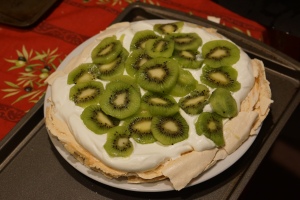I know, I know, I haven’t posted in a while. But I have a really good excuse: New Zealand.
This is the kind of thing that happens when you have a friend like Audrey, who gets it into her mind to gather a bunch of people together and jet off to New Zealand for two weeks. Why? Because we’re young, we’re unattached, we’re working good jobs with vacation time and enough money for plane tickets, and really, because why the hell not. So she marshaled an unruly group of nine of us, and masterminded an elaborate trip.
For two weeks we traveled most of the length of New Zealand’s north island, hopping from hostel to hostel on our way from Auckland to Wellington. And it was a fantasy. There were dense jungle-ish forests, and startling volcanic mountainsides, and psychedelic glowworm caves, and thermal hot springs in crayon colors, and beaches with jewel-green water, and all the glorious green rolling hills we’d hoped for, freckled with thousands of grazing sheep. We hiked and caved and walked and biked and Zorbed, and gorged ourselves on lamb and quiche and pastries and excellent white wine. I still haven’t fully processed it all–it was a fourteen-day sensory overload.
It was also rich kitchen fodder. I’ve got pocketfuls and pocketfuls of ideas for new recipes to try, inspired by the food we ate and the wine we drank. But to start off, here’s something I made before we even left: a kiwi pavlova.
This was my birthday cake of sorts, for a party the day before our flight to Auckland. I made it to be shamelessly thematic, since pavlovas were supposedly invented in New Zealand (or Australia, depending on whose side you take). It was named after the great Russian ballerina Anna Pavlova, and created as a way of embodying her delicacy and airiness in culinary form. It’s not especially popular in America–in fact, I’d never even heard of it until I decided to make one for myself. And now that I have, I’m totally confused, because pavlova is utterly divine.
So what is it, exactly? Think of it as a sort of meringue cake: a big crackly disc of meringue, slathered with whipped cream and studded with fresh fruit. The meringue for a pavlova is fortified with cornstarch and vinegar, which gives it a texture that I can only describe as “dreamy.” The outside is shatteringly thin and crisp, while the inside is spongy and light–like a marshmallow, only softer and more delicate. I take a tip from Nigella Lawson and flip my meringue upside down, so that the softer side that was next to the baking sheet is on top. That way, the bottom and sides keep all their crackly texture, and the whipped cream melds with the top of the meringue to produce the perfect creamy-chewy bite. It also hides a multitude of sins, since pavlovas have a tendency to crack and shatter all over the moment you touch them.
When it comes to topping a pavlova, the tradition is whipped cream and passionfruit pulp. But since passionfruits are impossible to come by in Northern California, I topped my pavlova with sliced kiwis instead. (I am nothing if not committed to a theme.) Any number of sliced fresh fruits or berries would work here, as would a healthy dollop of citrus curd swirled into the whipped cream. Really, the only important thing is that you choose a fruit that has some tartness to it, to balance the sugary meringue and the fatty cream.
Pavlova (serves 8)
Informed by a variety of sources
Note: If you’re not sure what the different “peak” stages of meringue look like, The Kitchn has a handy-dandy visual guide.
1 cup superfine (caster) sugar*
2 tsp cornstarch
4 large egg whites, at room temperature
1 tsp white wine vinegar
Pinch of salt
1 tsp vanilla extract
1 cup cold heavy whipping cream
Fresh berries or sliced fruit for serving
*To make superfine sugar, place 1 cup granulated sugar in a food processor and process for about 1 minute, or until fine and powdery.
Preheat the oven to 250º F, and position an oven rack in the middle. Line a baking sheet with parchment paper or a silicone mat. Fit an electric hand mixer or stand mixer with the whisk attachment.
In a small bowl, whisk together sugar and cornstarch. Set aside.
In a large (very clean) mixing bowl, or the bowl of the stand mixer, combine egg whites, vinegar, and salt. Start beating on low speed. When the egg whites begin to foam, increase the speed to medium and beat until the egg whites are just holding soft peaks. With the mixer running, add sugar mixture, 1 tbsp at a time, waiting until each addition of sugar is absorbed before adding the next. As you add the sugar, the egg whites will become thick and glossy.
Once all the sugar is incorporated, add vanilla extract and continue beating until the egg whites hold stiff peaks. To make sure the meringue is done, take a small amount and rub it between your thumb and index finger; it should be very thick and smooth, with no grittiness whatsoever.
Use a flexible spatula to scoop the meringue onto the center of the parchment-lined baking sheet, and form it into a flat-topped disc about 9 inches across. Bake for 1 hour 15 minutes, or until the meringue has turned a pale ivory color and is firm and dry to the touch. Turn off the oven and use a wooden spoon or other implement to prop the door open just a crack. Let the pavlova cool in the oven for 1-2 hours (or overnight), until completely cool. It may crack as it cools, which is fine.
Carefully invert the cooled pavlova onto a serving platter, and peel away the parchment. Whip the cream until it holds soft peaks, then slather it over the pavlova. Top with fruit, and serve immediately.


